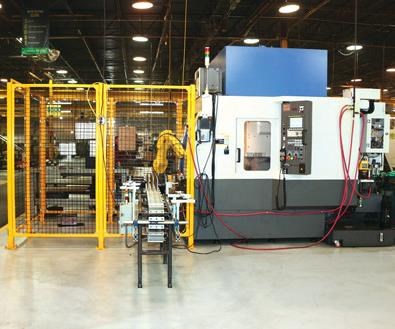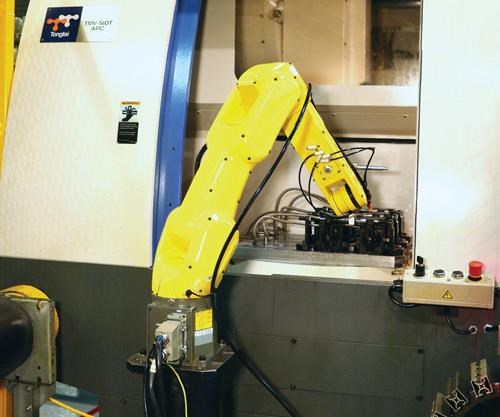Moving Automation In
This traditional Ohio-based screw machine shop worked with a system integrator and used its in-house expertise to create a sophisticated production cell to go along with its other automation forays.
The company began in 1939 and cut its teeth making bomb tips during World War II. Standby Screw Machine Products has steadily grown since that time, and now employs 150 people at its Berea, Ohio, headquarters and has a second operation in Guangzhou, China, which employees 200 people.
Standby Screw is like many old-school shops that have survived by being good at what they do. But unlike many old-school shops, several years ago Standby began to realize through increasing pressure from the industries it serves that instituting an automation mentality would allow it to supply a better quality product at a competitive price by a reduction of human error in the parts loading process.
The company serves the outdoor power equipment industry (primarily lawn and garden equipment), some automotive and a little bit of the fitness equipment industry. Most of the lawn and garden tractors in the field use Standby rear axles. Annually, Standby produces enough parts to supply more than 1 million walk-behind lawnmowers. In addition, Standby produces parts for snow blowers, chipper-shredders and garden tillers.
According to Bill Marcell, COO and president of this third-generation operation, “Our prior system was to load and unload singular and multiple parts onto fixtures using human labor. We still use human labor, but strategically implemented automation that allows us to use it in a different manner than before. Now we can focus on educating and training our employees in higher skill sets such as programming and robotics. This corporate mindset regarding labor allocation provides Standby with value-added employees who are able to work and produce on an advanced level, making each of them more critical to the process and success of Standby Screw.”
Standby is no stranger to automation, as the company currently has several pieces of automated equipment throughout its facilities for a variety of production processes. “We were not so much pressured to fill an increase in demand, but to reduce the internal costs of producing our current workload. We were not trying to replace workers (they are too hard to find), but rather apply their skills to higher value tasks,” Mr. Marcell says.
Shopping for a Cell
Visiting IMTS 2014, Standby found Absolute Machine Tools, which has the machines and integration capability Standby was looking for. Standby hoped to use more automated processes and achieve better quality.
Inconsistent hand loading of the machining centers was one of the quality issues the shop was dealing with. The goal came down to consistent loading using automation, rather than by hand, to place the part blanks in the precise spot, guaranteeing consistent loading. “We wanted a way to eliminate the human hand from touching the parts as much as possible,” Mr. Marcell recalls.
To achieve the goal of eliminating human parts handling, the company knew it needed a pallet changing machining center. The pallet would eliminate manual handling of the parts as much as possible.
The need was to run 17 different part numbers across the machine, including long and short axles, pump shafts, and motor shafts, all with different geometries made to the customer’s print. For many years, these jobs ran across six 20-year-old vertical machining centers.
Finding a Vendor
Automation and its integration is often not for the faint of heart. Few shops have the internal resources to install, tool, program and engineer the ancillary equipment to make a sophisticated, high mix cell operate as needed. There are many moving parts that must perform in the right sequence at the right time and with the least amount of parasitic time.
According to Mr. Marcell, “We knew the type of machine we needed, and for it to produce the family of parts we wanted to make, it needed to be automatically loaded. Also in our favor was that we had some experience with robots in other departments in the shop, so we weren’t on a fishing expedition. We are also blessed with some experienced in-house engineering talent.”
The Tongtai TMV-510T, with an automatic parts change pallet, proved it could process the array of parts for Standby and fit the bill for Mr. Marcell. He knew it needed to be automated. The machine is distributed by Absolute Machine, whose close Cleveland location is convenient and has full automation integration capability. Absolute Machine Tools is also a certified FANUC robotics integrator.
The Tongtai is a milling and tapping machining center with a built-in rotary pallet changer. It’s equipped with a FANUC 200iD 7L robot, which became the nucleus of the cell, which was what Mr. Marcell was looking for.
In order to get the part blanks to the robot, Jess Horvath, a Standby engineer, designed and built a conveyor system in-house to supply the robot with blanks in the correct order and orientation. It’s about 5 feet long and can continuously feed the robot from 25 to 45 minutes (depending on the part) without interruption. This was a big improvement over having a person load by hand.
The machine, robot and conveyor represent the hardware for the production cell. Linking them together to operate in the correct operations sequence is where the integration expertise comes in. It’s a workholding, timing and communication challenge, especially in a high mix application.
Integration: Breathing Life into a Cell
Connecting the components in a custom cell, such as Standby’s (and most others) are not a plug-and-play project. Craig Adorni, application engineer at Absolute, says, “My way is to go for simplicity when linking the components that need to communicate, the machine, the robot and
the conveyor.
“Some integrators want to hang a computer on each component. One works the robot, one works the conveyor and the CNC works the machine,” he continues. “On this installation, I use the machine’s CNC for control of the robot and conveyor linked by an Ethernet cable.
“The Ethernet lets the machine, conveyor and robot talk to each other. A single output cable from the computer is all that’s needed with proper integration,” Mr. Adorni says. “Without this single source link for communication between the components, it would have required readying all of the components independently, and then starting all of the systems in proper order to start the cell operation. With the use of the CNC controller, properly integrated, we are able to run the cell without the use of an HMI controller to add more components and complication for the end user to learn, maintain and operate. With the CNC being used as the cell master,
the operator needs to hit a single cycle start and the
whole thing begins running. It’s fully integrated and
totally automatic.”
He continues, “With this setup, if there is a problem, you hit ‘feed hold’ on the machine. Because of the Ethernet connection, the single feed hold also stops the robot and the conveyor allowing operators to access the machine for tooling changes, offset adjustments, in-process inspection of a part if needed, or perform whatever tasks might be needed without forcing the operator to perform a total reset and restart of the cell. Instead, when finished with the interruption, the operator simply hits cycle start and the cell comes back to life and picks up where it left off.”
Part Holding and Handling
Even a full line system integrator such as Absolute Machine Tools sometimes needs to look outside for some specialized suppliers. In the case of the Standby turnkey, that involved custom workholding to flexibly accommodate the mix of parts moving across the Tongai table and the grippers for the FANUC.
“We do a lot of work with Co-Op Tool (Toledo, Ohio) when it comes to specialized workholding and handling,” Mr. Adorni says. “For the application at Standby, the company came up with a custom design for quick-change holders that could accommodate the varying size and geometries of the fixture to handle all of the 17-plus part numbers running through the cell. In turn, all of the fixturing had to be automated (using hydraulics), so the robot could load and unload the parts on cue.
“We (Absolute) designed all the gripper components for the robots as far as the wrist, the hands and the gripper fingers. For this job, we found grippers with enough range to minimize setups on the robot itself, yet allowing enough room between the parts to remove them. If we used very long grippers, there was a risk of hitting the next part. The design worked,” he continues.
Together, these end effectors were designed to accommodate all of the diameters needed for the different shafts using only two sets of chuck jaws. This combination expedites change-overs in the fixturing, so the job-to-job change is quick and more importantly accommodates the entire part family.
Results
With the cell in place and operating, Mr. Marcell wanted to see what he had. “One part that started running in any real volume,” Mr. Marcell says, “was a part that Absolute set up for us. It ran at 130 percent efficiency compared with about 90-95 percent on the old mills. Moreover, we now have one person running two machines, when we used to have one man, one machine.
“Quality has been good. We haven’t seen an issue with misloaded parts. I did a 300-piece sample run and brought it to our quality department. The numbers were impressive. For that run, the Cpk was over 167, and the Ppks on the run were high. This job is fairly basic machining with only a few tight tolerances, but none out of the ordinary. The big leap for us has been eliminating loading errors, which have plagued us on the shop floor for years.”
Automating an existing process may often create expectations that are unrealistic. It’s true that improvements in throughput, quality and efficiency should be a given for such a project. However, shops such as Standby and Mr. Marcell understand the bigger picture.
In Standby’s case, the Tongtai cell brought more to the party. First, he was able to eliminate six machine tools with one, yet increase production. He was also able to man the cell with a single operator instead of two.
Moreover, because the cell is automated, those employees are able to be assigned to more value-added jobs in the shop besides simply loading and unloading parts and pushing cycle start.
With the right attitude about automation, the right application and the right system integrator, a little bit of automation can go a long way toward more efficiency and an improved competitive position.
Related Content
Automation Breakthroughs Revolutionize Precision Machining for Complex Parts
Marubeni Citizen-Cincom delivers custom solutions to address some of the biggest challenges in precision machining from handling small parts, to robot integration and unique tooling needs.
Read MoreStarting Small with Automation
Quick-change workholding and flexible robotic automation started this small shop on the path to success.
Read MoreZoller Event Shines Lights on Shopfloor Connectivity
The company’s open house event highlighted smart manufacturing solutions from CAM to part.
Read MoreHigh-Volume Machine Shop Automates Secondary Ops
An Ohio contract shop added a compact, self-loading CNC lathe to perform unattended secondary ops on a part for a key customer rather than running it on a manually loaded chucker.
Read MoreRead Next
Technology Advances Automation Trends
Shops of all sizes looking for better efficiency are realizing the benefits of a deeper investment into automation.
Read MoreA Tooling Workshop Worth a Visit
Marubeni Citizen-Cincom’s tooling and accessory workshop offers a chance to learn more about ancillary devices that can boost machining efficiency and capability.
Read MoreDo You Have Single Points of Failure?
Plans need to be in place before a catastrophic event occurs.
Read More













.jpg;maxWidth=300;quality=90)











